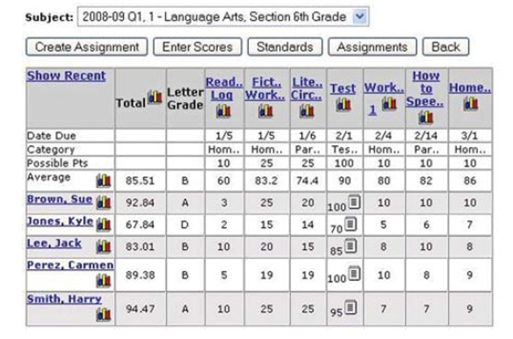Paper Grade-books Are Not Sufficient to Measure Student Learning
Commentary, Featured — By Paul Tyahla on January 13, 2012 at 9:04 AMMark ‘Jay’ Williams
Economics Fellow
While educators have been working to bring about technology in the classroom through the use of devices such as smart boards and interactive learning, the assessment of all that learning is often put into the same paper-based grade-books that were used when most of us were still in school. As the New Jersey Department of Education and more than 650 public school districts move to more comprehensive student and staff measurement models, the need for valid electronic classroom-level data is critically important. Unfortunately, the integration of electronic classroom grading systems has a long way to go before classroom-based formative and summative scoring can be utilized to comprehensively measure achievement.
Why? Because many districts, including the largest and most-financed, rarely have an all-grade, all-student electronic system that allows teachers to enter quiz, test and project grades into a computer for centralized processing and analysis. At best, report card grades, which are end of semester summative scores, eventually make their way into an electronic system. By that point, educators and policymakers are looking backward at a child’s comprehension and a teacher’s effectiveness, losing irreplaceable time in the process. Even worse, when this delay is coupled with the almost seven months needed to receive state testing information, student and staff grading happens after grade promotion.
What is an electronic grading system, or ‘live grade-book’? On a simplistic level, live grade-book software allows teachers to enter formative ( e.g. quiz and test grade) and summative (i.e. end-course grade) scores into a computerized system throughout the year. The centralized classroom-grading system can then be aligned with state testing scores to identify areas of concern at a student, teacher, and school level. On a more detailed level, live grade-books can act as an interactive platform for administrator, teacher and parent communication, a powerful classroom management tool through scheduling and interim reporting, and becomes a powerful basis for district-to-state data transfer and system-wide analytics.
Live grade-book software is not a new concept, and many districts have implemented any one of the multitude of commercially available products, enabling the districts to matriculate each grade level to the new software. There is a significant up-front software and integration expense, and many small districts do not have sufficient technology staff that can dedicate the time it takes to move even a low-enrollment district to a live grade-book platform. Many larger districts have only some grade levels or teachers consistently using any system. With more than 650 school districts, including charters, it is both economically feasible and necessary for effectiveness that the state to work with existing live grade-book vendors to develop and implement a state-wide web-based platform that provides real-time analytics to all stakeholders.
Below is an example of an intuitive easy-to-use web-based grade-book, and is only one of many free and fee-based live grade-book programs commercially available. The information this grade-book design captures is intuitive of what many non-educators expect is already in progress, but in reality, we have a long way to go before all 1.4 million public student and their teacher classroom-transaction data is captured.
Until the districts and state can capture measurement, evaluation, and assessment data at the student level in a fast-tempo environment, report card and state test analytics will always be lagging. Live grade-books increase the value of formative assessments, and can be used to help change the measured students and teacher behavior in a meaningful, immediate way.
Thirty years ago one of the great strategists of our time, William Boyd, coined the concept of the ‘O-O-D-A’ loop, which stood for observe, orient, decide, and act. Those organizations and individuals who can continuously process faster and faster through the O-O-D-A loop would have a decisive advantage. This concept is critically important when we are trying to change human behavior…response to good and bad behaviors must be immediate to be effective.
We can’t rely on old data to make new decisions. Particularly decisions where students and teachers futures are concerned and where billions of dollars of taxpayers resources are at stake.
About the Author
Mark ‘Jay’ Williams is an Economics Fellow at the Common Sense Institute of New Jersey, a non-profit organization dedicated to bringing free-market solutions to the public policy challenges facing New Jersey. Jay writes on economic issues for the K12, Higher Education, and Local Government sectors.
This article was first published by InTheLobby.net.
To download this article as a pdf, click here.







